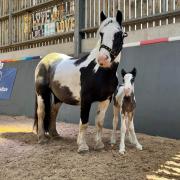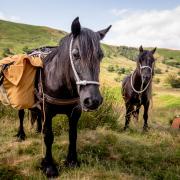One of the country’s last remaining swillers is keeping traditional skills alive in Grizedale Mike Glover reports

Woodswoman Lorna Singleton is one of only two full-time exponents in the UK of the ancient and endangered craft of swilling.
Makers of hand-crafted baskets once plied their trade in settlements throughout the fells and valleys north of the sands in Morecambe Bay. They were needed by the cocklers to sift the sand, hence the name. They were also used as carriers in the farms, factories, mines and mills which littered the Lakes landscape.
By the dawn of the 21st century, Owen Jones was the last of the swillers, operating out of Coniston. But he shared his skills with a few others. Now he and Lorna work together on their wood crafts before parting to make and market their wares.
There is far more to swilling than weaving the baskets, skilled as that craft is.

This time of the year is for winter felling. The pair work in privately-owned woods in Satterthwaite, Grizedale. First they cut out the birch trees, chopping and stacking the wood. It is mainly used as fuel, although it is also sold to other craft-makers for bowls and planking.
So how does a committed environmentalist justify taking down trees?
‘It is perfectly natural in virgin forest for trees to fall down through maturity and disease. The holes in the canopy let in the light for new young trees to grow, along with flowers and other plants,’ says Lorna.
Next comes the coppicing of oak, which takes advantage of the natural cycle. Garden-sized areas are worked at a time, over a 30-year rota.

Where clearance lets in the light bluebells, garlic and primroses are among the myriad species to flourish. This late spring stage is Lorna’s favourite time of the year.
‘We leave the roots, which store the energy, to send out hundreds of shoots which form the stems used in making our baskets. Research has shown that carefully coppiced trees last ten times as long as those which aren’t,’ she says.
Once harvested, the stems have their bark stripped off to be used in tanning leather. The tops are discarded for firewood and compost. Other sections are used for garden furniture, fences and lining paths.
Only the prime stems which are 8-10 inches in diameter are taken back to the workshop by Lorna. There she hammers wedges into the natural lines of the wood to form rough poles. The heart wood is discarded and the sap wood is boiled overnight.

Once softened, the wood can be torn and stripped into ribbons, with Lorna constantly ‘reading’ the wood to get the maximum effect. Finally the weaving can begin.
‘We make our baskets from this land. I want to use materials that grow naturally near me and have contact with the landscape,’ says Lorna.
Like the oak trees which she grows and uses – she planted 1,000 acorns last year – Lorna’s journey has not been a short one.
Now 36, she was born in Carlisle and grew up in Milnthorpe. As a child she was forever walking and cycling to Arnside and Silverdale, where there are plenty of coppiced woods, although Lorna didn’t know it at the time.
After Dallam School, she didn’t know what career path to follow and volunteered as a conservationist before taking a social anthropology and archaeology degree course in Manchester.
‘While volunteering I came across coppicing and had a light bulb moment,’ says Lorna.
She was apprenticed to Lytham-born Bill Hogarth MBE at his Trust based in Yealand Redmayne before taking Owen Jones’s swill basket course.
Lorna, who now has a workshop at Skelsmergh, near Kendal, says: ‘You can’t create swill baskets with machines. I use simple hand tools and techniques used by generations of swillers before me. The baskets are extremely durable.
‘When I’ve made a basket I want people to use it and pass it down to the next generation, as they did in a bygone era.
‘When I made my first swill in 2010 I was hooked. Since then I’ve put my heart and soul into making the baskets. It’s almost like my emotions are expressed in the finished product.’
As well as baskets, she designs and makes other contemporary products that show off the unique strength and flexibility of swill. This includes handbags and wall baskets.
With each basket taking the equivalent of three days work, they are not cheap. Prices start at £150.
But they last a lifetime and can be repaired if damaged. When finally finished with, they can be burnt or rot back into nature, leaving no polluting footprint.
As the world gradually wakes up to the dangers of plastic bags, it could be that these traditional skills, and the baskets they produce, will become ever more popular again.
Her work features in an exhibition called Crafting Change, at the Platform Gallery in Clitheroe until March 30.
Her creations are also on show at the Museum of Lakeland Life and Industry in Kendal, where she has an exhibition running until May 6.
Lorna is also running Basket Making Workshops at the museum on Saturday March 23 and Saturday April 27, 9.30am-5pm. Interest is so high, other sessions may be arranged.
Lorna is quite happy with the thought of training future competitors. ‘It is quite a pressure being one of the last exponents of this critically endangered craft. It would be great to have more people doing it,’ she says. u
For more information, go to lornasingleton.co.uk or lakelandmuseum.org.uk.



























